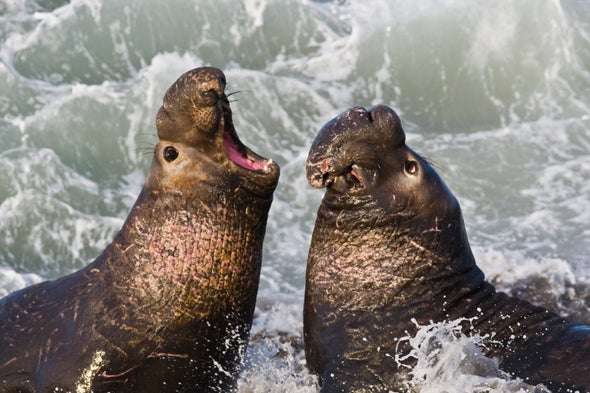(单词翻译:单击)
听力文本
This is Scientific American's 60-second Science. I'm Jason Goldman.
Deep in the inky depths of what's called the ocean's mesopelagic zone, more than 500 meters below the surface, the main source of light is not the sun—even during the day. Most of the light comes instead from bioluminescent organisms, creatures that produce their own light. It's in these dark depths that southern elephant seals love to feast on squids and fish.
"Initially we wanted to know how elephant seals find their prey in the dark."
Pauline Goulet from the University of St. Andrews Sea Mammal Research Unit.
Thanks to data-logging technology, researchers have a fairly good handle on how far elephant seals travel to feed—and how long and how deep they dive. But nobody really knew how they find their prey in the darkness. Do they track the lights? Or is something else going on?
"So we built a sensor that could pick up flashes produced by animals that were being hunted by the elephant seal, because we thought that elephant seals might be looking for that light to catch a snack."

But it turned out that the fish actually used their bioluminescence to disorient seals after the seals began their attack.
"The thing is it seemed that the flashing prey were harder to catch than the nonflashing prey—which we found out by looking at the duration of the chase, which was longer for flashing prey."
The fish flash was always emitted just after the seal launched an attack, making it a defensive, reactive maneuver to distract the seals. But at least one seal learned to turn that liability into a hunting strategy.
"This seal appeared to be a master in catching the flashing prey, because each time it tried to catch a prey, first it would do this little head movement that was probably mechanically sensed by the prey. Then it would induce the prey to flash, because the prey reacts to this approaching predator."
This seal would twitch her head, see where the light came from and only then start the chase.
So even if some seals can use bioluminescence as a way to find food, for most the light is a distraction. Goulet thinks that seals probably rely more on their whiskers to sense the movements their prey make in the water.
"It's just a step forward into understanding what's happening in these depths, in this ecosystem that we don't really know much about—especially in the Southern Ocean."
Thanks for listening for Scientific American's 60-second Science. I'm Jason Goldman.
参考译文
这里是科学美国人——60秒科学。我是杰森·古德曼。
在海面以下500多米被称为海洋中层带的漆黑深处,主要光源也不是阳光,即使在白天也是如此。大多数光线来自生物发光的有机体,即自已产生光的生物。正是在这些黑暗的深处,南象海豹开心地享用乌贼和鱼。
“最初我们想知道南象海豹如何在黑暗中找到猎物。”
圣安德鲁斯大学海洋哺乳动物研究部的波琳·古莱特说到。
得益于数据记录技术,研究人员对南象海豹的觅食距离、下潜距离和深度有了相当好的了解。但没有人知道他们如何在黑暗中找到猎物。它们是追踪光线吗?还是有别的方法?
“我们制造了一个传感器,可以接收到被南象海豹捕获的动物发出的闪光,因为我们当时认为南象海豹可能通过追寻光来捕食。”
但结果发现,鱼类实际上是在海豹开始攻击后,利用自已的生物发光来让海豹迷失方向。
“关键是闪光的猎物似乎比不闪光的猎物更难捕捉,我们通过观察追捕的持续时间发现,追捕闪光猎物要花更长时间。”
鱼总是在南象海豹开始攻击后再发出闪光,使其成为一种防御性的、反应性的策略,以分散海豹的注意力。但至少有一只海豹学会了将这种不利因素转化为捕猎策略。
“这只海豹似乎是捕猎闪光猎物的高手,因为每次它试图捕获猎物时,它会先稍微动下头部,这很可能被猎物机械性地感觉到。之后它会诱导猎物闪光,因为猎物会对靠近的捕食者做出反应。”
这只海豹会晃动头部,看看光来自哪里,然后才开始追捕。
因此,即使有些海豹可以利用生物发光来寻找食物,但对大多数海豹来说,光会分散它们的注意力。古莱特认为海豹可能更依赖它们的胡须来感知猎物在水中的动作。
“这只是进一步了解在这些海底深处、这种生态系统中发生的情况,我们对二者都不太了解,尤其是南大洋的情况。”
谢谢大家收听科学美国人——60秒科学。我是杰森·古德曼。
译文为可可英语翻译,未经授权请勿转载!
重点讲解
重点讲解:
1. thanks to 幸亏;归因于;
Thanks to the automobile, Americans soon had a freedom of movement previously unknown.
由于有了汽车,美国人很快就获得了前所未有的行动自由。
2. have a handle on (理解、解决问题的)方法,途径;
This one was a doozy but we think we finally have a good handle on it now.
这个问题有点麻烦,不过我们认为现在已经能很好的处理它了。
3. react to (作出)反应;回应;
Someone allergic to milk is likely to react to cheese.
对牛奶过敏的人可能对奶酪也有不良反应。
4. rely on 依赖;依靠;
Many animals rely on concealment for protection.
许多动物靠藏匿自己来避害。


